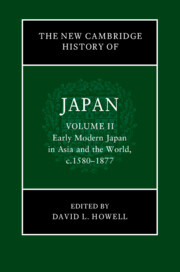Book contents
- The New Cambridge History of Japan
- The New Cambridge History of Japan
- The New Cambridge History of Japan
- Copyright page
- Contents
- Figures
- Maps
- Tables
- Contributors to Volume II
- Preface
- Frontispiece
- Introduction
- Part I The Character of the Early Modern State
- PART II Economy, Environment, and Technology
- 7 International Economy and Japan at the Dawn of the Early Modern Era
- 8 The Tokugawa Economy
- 9 The Pacific Context of Japan’s Environmental History
- 10 Scientific Communities and the Emergence of Science in Early Modern Japan
- 11 The Problem of Western Knowledge in Late Tokugawa Japan
- 12 Technology, Military Reform, and Warfare in the Tokugawa-Meiji Transition
- Part III Social Practices and Cultures of Early Modern Japan
- Index
- References
10 - Scientific Communities and the Emergence of Science in Early Modern Japan
from PART II - Economy, Environment, and Technology
Published online by Cambridge University Press: 15 January 2024
- The New Cambridge History of Japan
- The New Cambridge History of Japan
- The New Cambridge History of Japan
- Copyright page
- Contents
- Figures
- Maps
- Tables
- Contributors to Volume II
- Preface
- Frontispiece
- Introduction
- Part I The Character of the Early Modern State
- PART II Economy, Environment, and Technology
- 7 International Economy and Japan at the Dawn of the Early Modern Era
- 8 The Tokugawa Economy
- 9 The Pacific Context of Japan’s Environmental History
- 10 Scientific Communities and the Emergence of Science in Early Modern Japan
- 11 The Problem of Western Knowledge in Late Tokugawa Japan
- 12 Technology, Military Reform, and Warfare in the Tokugawa-Meiji Transition
- Part III Social Practices and Cultures of Early Modern Japan
- Index
- References
Summary
The Tokugawa period saw a transformation in the systematic inquiry into nature. In the seventeenth century scholars were engaging in discrete fields of study, such as astronomy or medicine. But over the course of the next two centuries the fields that initially seemed distant and unrelated gradually converged into one enterprise that we now call “science.” Although Japanese scholars were not isolated from European science, it was not the outside influence that caused this transformation. Rather, the new conceptualization of science came from within, as different scholars came to align themselves along different lines. What brought them together was no longer social status, practical goals, or even their respective disciplines, but the kind of questions they asked, the kind of evidence they considered acceptable, and the sources they deemed authoritative. Together, they now engaged in Science, with a capital S, that was greater than the sum of its parts.
Keywords
- Type
- Chapter
- Information
- The New Cambridge History of Japan , pp. 342 - 362Publisher: Cambridge University PressPrint publication year: 2023

